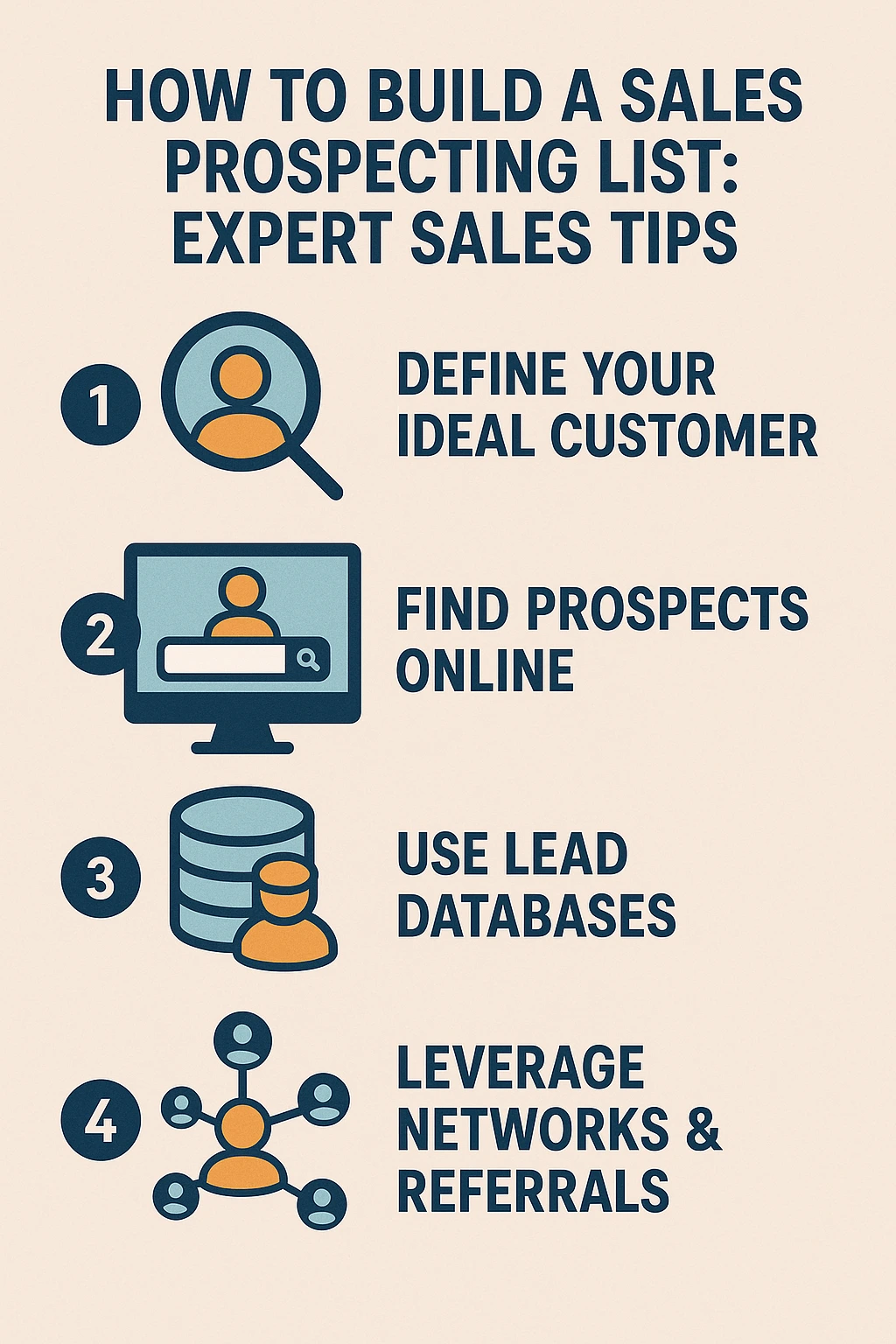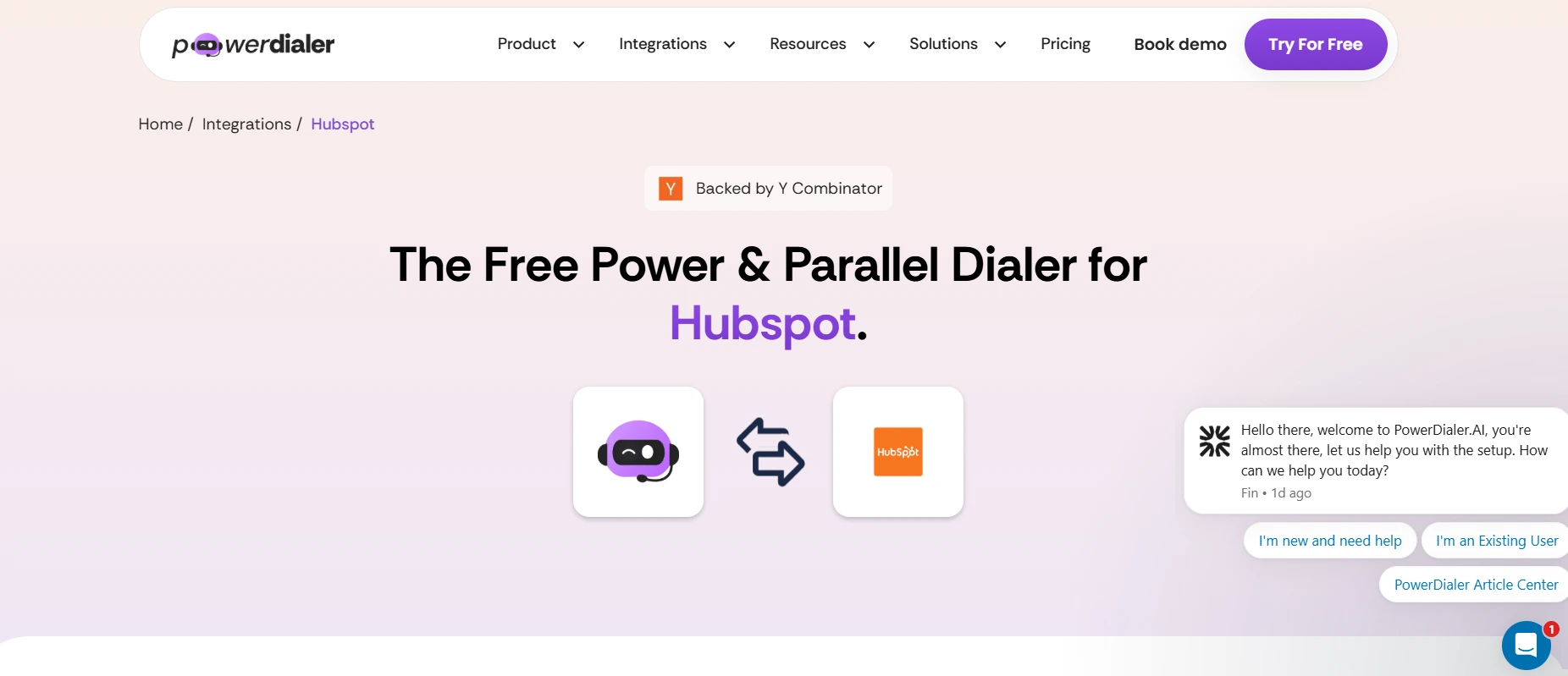
How to Build a Sales Prospecting List: Expert Sales Tips
Summary:
Building a sales prospecting list is no longer just about collecting names and numbers, it’s about finding the right people, at the right time, with the right tools. In today’s competitive sales environment, manual prospecting wastes valuable hours and leaves opportunities on the table. That’s why successful sales teams turn to proven strategies and modern tools to create targeted lists that actually convert.
In this guide, we’ll share expert tips from four sales leaders on how to build a high-quality prospecting list. From using AI-driven dialers like PowerDialer.ai to leveraging databases such as ZoomInfo and relationship-based platforms like LinkedIn Sales Navigator, you’ll learn step-by-step how to streamline your outreach, improve accuracy, and close more deals.

Creating a list of sales prospects is more than just piling up names and emails. It's the key to your sales success. Without a focused list, even the best sales rep will spend hours chasing unqualified people. However, an informed and well-kept list will fill your sales pipeline with qualified prospects who are actually interested in your solution.
The challenge? 68% of B2B salespeople confess that prospecting is the most difficult aspect of their job. From finding the correct individuals to confirming their contact information, the process might seem overwhelming.
That is why we consulted four experienced sales leaders for their advice. In this guide, not only will you see how to create a prospecting list step by step, you will also find expert tips on how to make your list high-performing and generating revenue.
What Is a Sales Prospecting List?

A prospect list for sales is a hand-curated database of prospects who match your ideal customer profile (ICP). It contains names, job function, company, contact information, and often enriched data like pain points, current software stack, or recent business activity.
Why It Matters in Sales Growth
Consider this: there are only so many hours in a day that sales reps have. If they're squandering them by calling or emailing individuals with no intent to purchase, the outcomes will always be underwhelming. A focused prospecting list guarantees every outreach attempt, email outreach or cold calling leads, is made with individuals who have a propensity to make a purchase.
HubSpot cites that companies having their prospecting lists aligned with their ICP enjoy a 37% win rate. That's the magic of having quality contacts.
Generic Leads vs. Targeted Prospects
Generic Leads: Bought from low-cost vendors, usually stale, and contain unqualified names. Example: contacting interns when you actually need decision-makers.
Targeted Prospects: Qualified contacts that meet your ICP, e.g., Marketing Directors at SaaS businesses with $10M+ revenue.
Bottom line: A targeted sales prospecting list saves time, reduces frustration, and dramatically improves conversion rates.
Steps to Build a Sales Prospecting List
Define Your Ideal Customer Profile (ICP)
The Ideal Customer Profile (ICP) is your guide for sales prospecting lists, it allows you to target only those accounts that have the highest likelihood of purchase. An ICP delineates the ideal customer on characteristics such as industry, company size, geography, revenue, job function, and shared pain points. Mapping these pieces of information keeps sales teams from pursuing the wrong kinds of leads and instead gets them to pursue prospects that fit their solution. A solid ICP not only saves time but also maximizes conversion rates and reduces the sales cycle. Without that, prospecting is cold calling with little return.
What goes into an ICP?
- Industry or Vertical: e.g., Healthcare SaaS, Manufacturing Automation.
- Job Roles: Decision-makers (CEO, VP Sales, IT Head).
- Company Size: Employee headcount or revenue thresholds.
- Geography: Local, regional, or global.
- Pain Points: Challenges that your product addresses (e.g., inefficiency in sales, high churn).
Example: Selling an AI dialer, your ICP could be Sales Managers of mid-sized B2B SaaS firms with 20–50 reps who do manual dialing.
Why it matters: Reps with a specific ICP save hours and increase outreach success.
Research and Identify Target Accounts
Now that you know your ICP, the next task is prospect research.
Tools & Sources:
- LinkedIn Sales Navigator: Role, industry, company size advanced filters.
- ZoomInfo & Apollo: Deliver verified email, direct dial, and company data.
- Crunchbase: Great for monitoring startups, rounds of funding, and growth indicators.
- Industry Directories: Chamber of Commerce, industry associations.
Use Firmographic + Technographic Data:
- Firmographic: Company size, location, yearly revenue.
- Technographic: Tools or platforms already being used by the company (e.g., HubSpot, Salesforce).
Sales teams that use enriched data report 27% higher close rates.
Use the Correct Tools for Prospecting
Pursuing each prospect individually is too time-consuming. That is why today's sales teams use specialized tools that automate research, validate contacts, and even rank outreach. Here are four of the best tools for creating and maintaining a sales prospecting list, and their pluses and minuses.
PowerDialer.ai

PowerDialer.ai is an auto-dialer that uses AI with CRM integration for high-volume outreach. It enables sales reps to make more calls per unit of time, while AI recommends the most suitable prospects to call first. The solution not only accelerates calling but also enhances lead data, monitors call results, and offers insights into prospect activity. Through its effortless integration into leading CRM software, sales managers have real-time visibility into team performance and pipeline activity.
Pros:
- AI-powered lead prioritization enhances conversion opportunities.
- Smooth CRM integration maintains data in one place.
- Real-time call tracking and analytics.
- Conserves time with voicemail drops and auto-dialing.
- Facilitates personalization with enhanced lead information.
Cons:
- Needs onboarding to be fully functional.
- Optimizes with stable internet connectivity.
- Potentially overwhelmed by very small sales teams.
- Some advanced analytics tools are paid.
- Reps require training to use AI recommendations properly.
Apollo.io
Apollo.io integrates data enrichment, validated contact information, and outreach sequencing into a single platform. It's particularly favored by startups and SMBs due to its cost-effectiveness. Sales representatives can create segmented lists from filters such as job title, industry, and geography, and send email sequences directly from the platform. Apollo's Chrome extension also allows easy importing of prospect data directly from LinkedIn and adding it to your sales pipeline immediately.
Pros:
- Affordable in comparison to enterprise solutions.
- Verified accurate emails with minimal bounce rates.
- Time-saving built-in email sequencing.
- Simple-to-use Chrome extension for LinkedIn prospecting.
- Excellent data coverage to outreach automation balance.
Cons:
- Database not as large as ZoomInfo's.
- Phone numbers are missing on some international contacts.
- Reporting capabilities are rudimentary.
- Advanced filters can feel restrictive for enterprise requirements.
ZoomInfo
ZoomInfo is a B2B premium data platform that boasts a huge database of vetted contacts and companies. It provides firmographic, technographic, and intent data, positioning it well for enterprise prospecting. ZoomInfo can be integrated into most CRM systems and can reveal decision-makers, direct dials, and company information at scale. It's particularly useful for large sales teams that require accurate, worldwide data to fuel their outbound sales process.
Pros:
- Industry-leading database size and accuracy.
- Direct dials and mobile numbers available.
- High-quality intent data to reach in-market buyers.
- Robust CRM integrations to automate workflows.
- Great for enterprise prospecting at scale.
Cons:
- Too costly for startups and small teams.
- Feels overwhelming to new users.
- Data accuracy is inconsistent in smaller markets.
- Some features gated behind higher price points.
- Needs regular training to be used effectively.
LinkedIn Sales Navigator
LinkedIn Sales Navigator is the ultimate tool for relationship prospecting. Sales reps can use it to filter LinkedIn's huge professional network by role, industry, geo, and more. Leads can be saved, company updates followed, and even who's interacted with their content viewed. While databases are terrible at providing context for personalized cold outreach, Sales Navigator is great at providing context for personalized outreach, perfect for establishing long-term relationships instead of mass cold outreach.
Pros:
- Access to LinkedIn's 1 billion+ professionals.
- Advanced filters for target prospecting.
- Live job change and company news updates.
- Ideal for social selling and warm lead outreach.
- Simple to connect with CRM and outreach platforms.
Cons:
- No direct dials or verified emails are provided.
- Not ideal for bulk list building versus data platforms.
- Expensive as an independent tool.
- Best performance is best achieved with an active personal LinkedIn profile.
- Data exporting may be limited.
Why tools are important: InsideSales says reps dedicate 35% of their time to manual research. Automation can reduce this by half, allowing salespeople to talk rather than type away at spreadsheets.
Segment and Qualify Leads
A prospecting list should never be a one-size-fits-all approach. Segmentation ensures your outreach is meaningful.
How to Segment:
- By location (North America, APAC, EMEA).
- By company size (startups vs. enterprises).
- By job function (C-level vs. operational managers).
Qualification Frameworks:
BANT: Budget, Authority, Need, Timeline.
MEDDIC: Metrics, Economic Buyer, Decision Criteria, Identify Pain, Champion.
Example: A lead might seem ideal on paper but unless they have the budget (BANT), they aren't worth pursuing at the moment.
Keep Your List Current and Clean
People change jobs constantly. LinkedIn states job turnover is 10–15% annually. That leaves up to 20% of your list potentially stale in 12 months if you don't update it.
Best practices:
- Use tools like NeverBounce or ZeroBounce for email verification.
- Clean lists quarterly to avoid high bounce rates.
- Remove unresponsive leads after several attempts.
A clean list = better deliverability, higher conversions, and fewer wasted calls.
Expert Tips from 4 Sales Leaders
Tip 1: Focus on Quality Over Quantity
“500 targeted prospects will outperform 5,000 random leads every time,” says Maria Lopez, VP of Sales at a SaaS firm.
The takeaway: focus on relevance over quantity.
Tip 2: Take Advantage of Multi-Channel Research
John Miller, Sales Director, advises not to only use LinkedIn. "Some of my most valuable leads were generated from trade shows, webinars, and industry organizations. If you limit yourself to a single channel, you are missing out."
Tip 3: Personalization Begins with Data
By Sarah Kim, Head of Sales Operations:
"Your pitch is only as strong as your data. If you know your prospect's challenges, you can personalize at scale."
Tip 4: Continuously Optimize Your List
Mark Jensen, CRO, advises keeping your list as a living document. "Add new prospects, refresh data, and prune dead leads weekly. Prospecting is never finished."
Common Mistakes to Avoid in Building a Prospecting List
- Purchasing Cheap Lists: Thank old contacts and high bounce rates.
- Skipping Verification: Results in wasted dials and worse sender reputation.
- Chasing Vanity Metrics: Pursuing large brands not aligned with your ICP.
- Ignoring Segmentation: Sending the same message to everyone.
Top Tools to Construct and Maintain Sales Prospecting Lists
AI-Driven Dialers & CRMs
PowerDialer.ai:
Marries AI auto-dialing with CRM integration. It recommends the optimal time to call, enriches contact information, and monitors performance.
Pros:
Speeds up calling, decreases manual labor, assists in lead prioritization.
Cons:
Takes time to onboard new users.
Data Platforms
ZoomInfo – Most suitable for enterprises requiring verified, international databases.
Apollo.io – Low cost for startups, excellent balance of features.
Clearbit – Most suitable for enriching existing databases with technographic information.
Lead Management Tools
HubSpot CRM – Easy to use and free to begin.
Salesforce – Most suitable for enterprise workflows that are complex.
Pipedrive – Most suitable for small and mid-sized teams requiring visual pipeline management.
Conclusion
A well-structured sales prospecting list can make the difference between missed quotas and consistent revenue growth. By defining your ICP, researching deeply, leveraging automation tools, and keeping your list fresh, you’ll ensure your team spends time on the right prospects.
Sales leaders agree: prospecting isn’t a one-time task. It’s a process of building, refining, and optimizing.
Want to save hours building your sales prospecting list?
Try PowerDialer.ai, the AI-driven auto-dialer that plugs into your CRM, enriches leads, and gets you connected with the right prospects in a shorter time.
FAQs
Q1. How is a sales prospect different from a sales lead?
A lead is an unqualified contact, whereas a prospect aligns with your ICP and has real potential.
Q2. How frequently should I update my sales prospecting list?
At least quarterly, or monthly if your business has high turnover.
Q3. Can I simply purchase a sales prospecting list?
You can, but anticipate poor ROI. Custom-built lists are better at converting.
Q4. How do I quickly create a B2B prospecting list?
Employ AI-powered tools such as PowerDialer.ai and LinkedIn Sales Navigator.
Q5. How many prospects should be on my list?
This varies based on your sales cycle. Prioritize quality over quantity.
